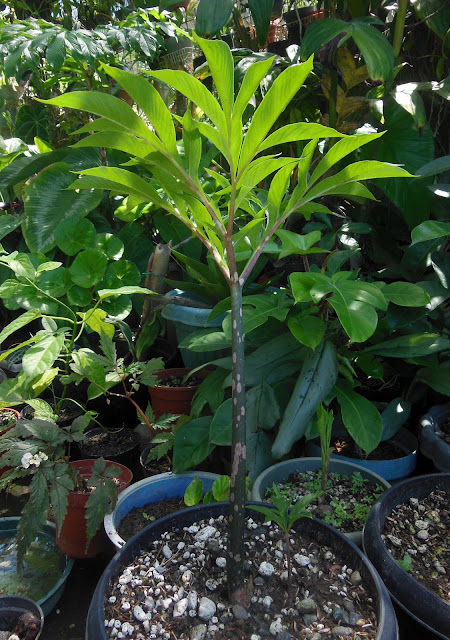An aberrant Amorphophallus paeoniifolius
One of the idiosyncracies of collectors is that when they have achieved a certain number of plants, they lose track of a lot of things, including their plants' provenance, source, and even names. Just recently an Amorphophallus impressus bloomed here, and even today I still can't figure out how or when I acquired it. Same goes for the plant shown here.
The plant at hand is a specimen of A. paeoniifolius, which is the most commonly encountered Amorphophallus species anywhere in Asia. I have some plants here, both potted and grown directly on the ground, but one is a bit of an oddity. As you probably already know (assuming you are familiar with these plants), one of the features of this species is the much tubercled petioles, which are raised and appear as prickles. Even a blind man can discern a paeoniifolius just by running his fingers on its petiole. But one plant I have has a smooth petiole.
Compare the one above to the ones below. The one on the right is a new growth, and it is normal for this species to develop the tubercles as the leaf ages.
And here is another example of a typical A. paeoniifolius:
It is only a few weeks ago that I noticed this plant. Very likely it's been here for a few growing seasons already, but it is only now that the aberrant trait manifested to be noticeable enough. One may even begin to advance the idea that this plant may be a natural hybrid, and although possible, I am not keen on entertaining the thought, at least for now. But maybe in a few years we'll see it blooming and by then we can tell if this plant is special more on its petiole alone.
The plant at hand is a specimen of A. paeoniifolius, which is the most commonly encountered Amorphophallus species anywhere in Asia. I have some plants here, both potted and grown directly on the ground, but one is a bit of an oddity. As you probably already know (assuming you are familiar with these plants), one of the features of this species is the much tubercled petioles, which are raised and appear as prickles. Even a blind man can discern a paeoniifolius just by running his fingers on its petiole. But one plant I have has a smooth petiole.
And here is another example of a typical A. paeoniifolius:
It is only a few weeks ago that I noticed this plant. Very likely it's been here for a few growing seasons already, but it is only now that the aberrant trait manifested to be noticeable enough. One may even begin to advance the idea that this plant may be a natural hybrid, and although possible, I am not keen on entertaining the thought, at least for now. But maybe in a few years we'll see it blooming and by then we can tell if this plant is special more on its petiole alone.









Comments
Post a Comment